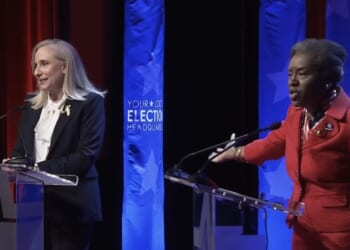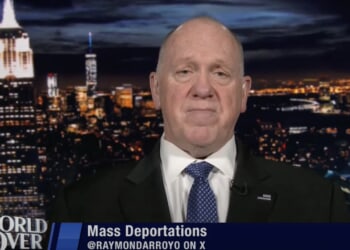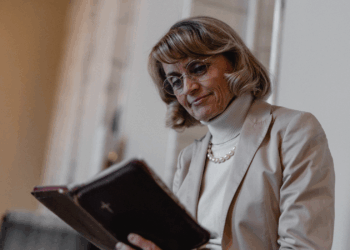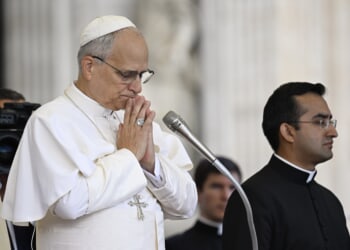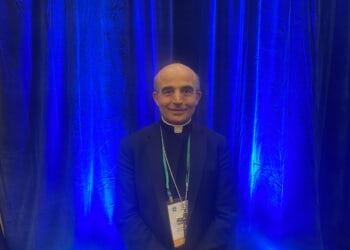England is in political meltdown — there is social unrest — and the state Church is in serious decline.
While all three of the above are related, it is the church that belies division within the “United Kingdom.”
For the first time in the history of the five-century-old institution, a woman will lead the Church of England. The Rev. Sarah Mullally was appointed the 106th archbishop of Canterbury recently; she will become the spiritual leader of the 85 million Anglican faithful globally. And this includes 1.5 million Episcopalians in the U.S. — a number that continues to decline.
Wife and mother of two, Mullally will soon walk in the footsteps of the 12th-century Roman Catholic martyr Thomas à Becket, 16th-century martyr, Thomas Cranmer — the first to hold the ecclesiastical seat for the Church of England — and the renowned scholar and ecumenist of the 20th century, William Temple.
Mullally, a former nurse in Britain’s National Health Service, has for the past seven years served as the liberal Church of England’s progressive-minded bishop of London — the first woman to hold that position. She had previously been the U.K. government’s adviser on nursing — the youngest person ever to be so appointed.
It is one of those roles where good can result, but as with her predecessor, who advocated acceptance of virtually all things secular, it is a role in which the incumbent can also do a great deal of damage.
But before we get too caught up in the prestige of high office, there are a few things to consider: the archbishop of Canterbury has virtually no formal powers. The ecclesiastical seat is considered to be primus inter pares (first among equals); the office holder gets a seat, alongside other “Lords Spiritual,” in the House of Lords. It is one of those roles where good can result, but as with her predecessor, who advocated acceptance of virtually all things secular, it is a role in which the incumbent can also do a great deal of damage.
The role is symbolic — it’s about appearances — and the liberal leadership of the church has thrown down the gauntlet; it is sending a message. The Church of England has entrenched itself in a liberal ideology.
The fact that the new archbishop is a woman is not the issue — her controversial liberal views are.
Diverse Demographics
England’s state church is in serious trouble and, as is often the case with institutions, the reason is found in the numbers. The demographics of the Anglican Communion have shifted; Africa now holds the majority of the faithful. As of 2025, the Anglican population in Africa is roughly 43 million, with the largest communities found in Nigeria, Uganda, and South Africa. The Church of Nigeria alone claims approximately 25 million members, making it the largest province in the “Communion.” (RELATED: Ted Cruz and the Specter of ‘Roland, the Headless Thompson Gunner’)
In contrast, Church of England numbers within Britain itself denote a harsh reality: the “Church” has lost 160,000 attendees across an average week, including Sundays, since 2019, when 854,000 people attended its churches. Since 2003, the all-age average weekly attendance has declined from 1,126,000. (RELATED: Why All Christians Must Reject DEI)
With the population of England now around 68 million, 685,000 worshippers in 2023 means barely 1 per cent of the people living in the nation are turning up to fill Anglican pews.
And this despite the Church of England being an institution possessing enormous advantages over other Christian denominations and religious groups there. It is “the Church” by the Act of Supremacy (1534) established in England, with 26 of its bishops entitled to and being compensated for the privilege of a seat in the House of Lords. Its Church Commissioners manage an endowment fund worth £11.1 billion. It has 16,000 buildings across England and 4,630 schools teaching about 1 million children.
Yet, forecasts suggest the virtual extinction of the Church of England on the shores of Britain in the 2060s — thus, the scope of the problem. And it just got worse.
Church of England Splits in Two
This last week, the Church of England hit another milestone in its 491-year existence since Henry VIII created it in rebellion against the Vatican — the latter had refused the king’s petition to ditch Catherine of Aragon and consummate his infatuation with Anne Boleyn — one of several “unions” that will not work out.
The head of the Global Anglican Future Conference (GAFCON), a coalition of Anglican leaders opposing the liberalization of the Anglican Church, announced on Thursday that they would split from Canterbury, declaring itself the true leadership of the Church.
Most Revd Dr. Laurent Mbanda, the chairman of the GAFCON Primates’ Council and the Primate of the Anglican Church of Rwanda, published a letter declaring that the true Anglican Church was now under GAFCON — not the Archbishop of Canterbury, as it had been for five centuries. The letter is a direct response to Mullally’s selection for the role.
The new archbishop’s appointment in early October triggered widespread outrage in the most conservative churches under Anglicanism. Critics noted that Mullally publicly supported blessing gay marriages and “supported pro-LGBTQ initiatives within the Communion” as well as other positions described as “liberal” — like being pro-abortion when “the Church” itself says otherwise. (RELATED: Catholic Cognitive Dissonance)
So here we are; history is made, and another woke agenda has been satisfied. The Church of England, which cannot fill its pews and cannot seem to decide what it actually believes about Christianity, now has a leader who embodies its most fashionable, trendy, and provocative views. It does not seem to matter that fewer people than ever attend its services (since it embarked on its woke adventure with the previous leader in Canterbury) or that the liberal folks “the Church” is now trying to attract know more about the Kardashians than the Commandments. (RELATED: How to Write About Christianity While Knowing Nothing About It)
Does the Church of England today — with membership in Britain declining steadily — have any idea what it wants to be, or is it just about how it wants to be viewed: where truth is whatever one says it is, where meta-narratives like English history and traditions (ecclesiastical and otherwise) are eschewed, where objective truth has given way to relativism? Is it just about being “postmodern” in the eyes of people who don’t understand why patriotic Brits in the countryside hoist the flag of St. George on businesses, homes, and churches, and think “Unite the Kingdom” protests are contrary to what it means to be British?
Perhaps, in time, the faithful remnant will find solace if not in sermons or scripture, but in the comforting knowledge that — at least — the archbishop’s pronouns will be politically correct.
READ MORE from F. Andrew Wolf Jr.:
Trump’s Economic Success Leaves Liberals Red-Faced


